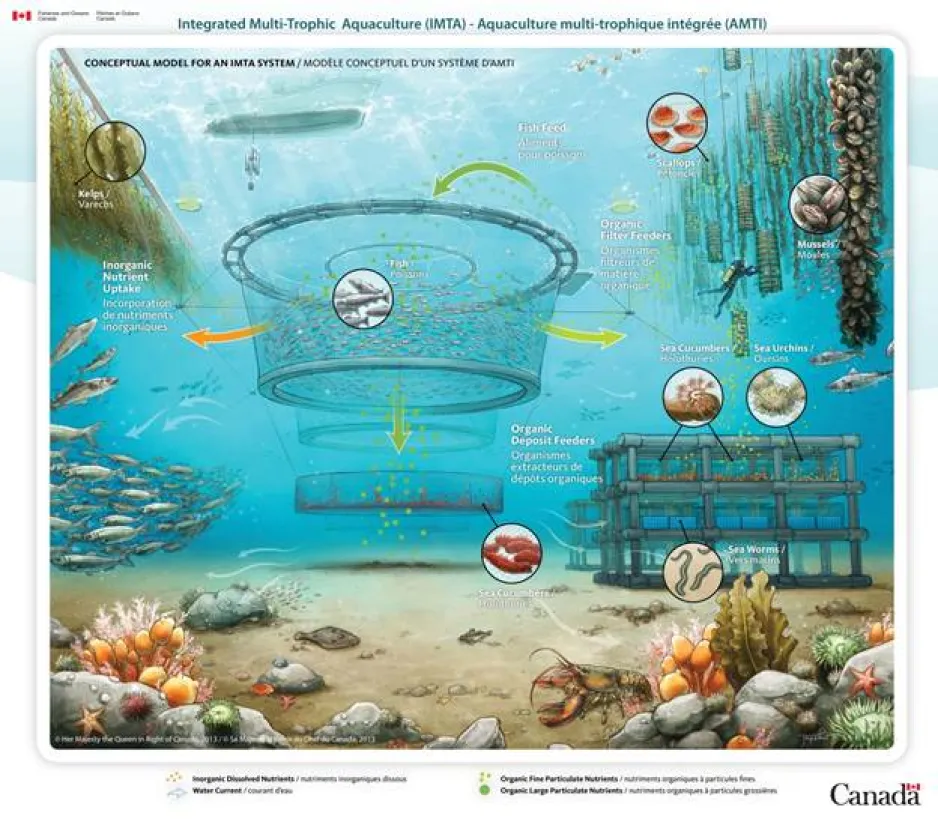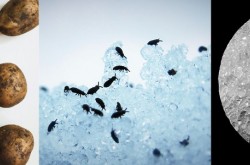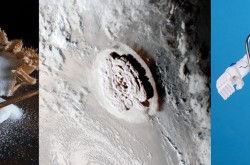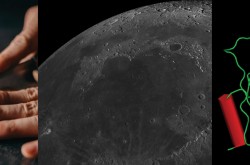2 Things you should know about an integrated aquaculture system and discovering more of Saturn's moons

Meet Cassandra Marion and Renée-Claude Goulet.
They are two of Ingenium’s science advisors, providing expert scientific advice on key subjects relating to the Canada Aviation and Space Museum, and the Canada Agriculture and Food Museum.
In this colourful monthly blog series, Ingenium’s science advisors offer up quirky nuggets related to their areas of expertise. For this June edition, Cassandra Marion has invited Jesse Rogerson — professor in the Natural Sciences department at York University — to fill in. Together, our experts explain how recreating nature's recycling system can lead to greener aquaculture, and how more of Saturn's moons were recently discovered.

Farmed fish are reared in net pens in water near land. A sight like this might get a lot busier in the future!
How recreating nature's recycling system can lead to cleaner waters
Aquaculture in Canada - farming fish, algae, and shellfish for food - represents about 20 percent of Canada's total seafood production. Though most farms are specialized, focusing on meeting the needs of a single species or type of organism, another way of farming the waters is on the horizon, one that draws inspiration from nature's own recycling system.
In order to produce more seafood to meet growing demand, and to minimize the impact of fish farms on the local aquatic environment, researchers have studied a farming system called Integrated Multi-Trophic Aquaculture (IMTA). This means growing multiple species together that come from different levels of the food chain. Researchers are finding that in water, just like on land, incorporating multiple species in the same system can improve sustainability by reducing the amount of waste released in the surrounding ecosystem, and producing more food with fewer inputs.

A conceptual model for an Integrated Multi-Trophic Aquaculture (ITMA) system.
There are four components to the IMTA system: finfish (Atlantic salmon, sablefish), seaweeds (kelp), filter feeders (mussels, scallops), and bottom feeders (sea urchins, sea cucumbers). Each of these has its own needs in terms of food source, and each creates different types of waste. Typically, species are farmed separately, but IMTA aims to combine the organisms in one system and "close the loop."
Seaweeds, filter feeders, and bottom feeders take their nourishment from the surrounding water and ocean floor. On the other hand, farmed fish are contained in a net pen, and eat the feed that farmers put in the water. Excess feed and fish feces accumulate below the pen. In the IMTA system, the bottom feeders, reared below the net pen, eat the wastes. The filter feeders around the fish net pen clean the water by removing the floating bits of feed and fish feces. Finally, the seaweeds take in the dissolved nitrogen and phosphorous in the water that are released by the fish and other organisms.
There is still a lot to learn about the benefits, drawbacks, and economics of these integrated multi-trophic aquaculture systems, and research is ongoing in Canada to explore them as a commercially viable option for our aquaculture industry. One of the reasons IMTA systems have not been adopted widely yet is that it's difficult to measure exactly how good they are at capturing waste. This is because there are so many different and fluctuating environmental factors that can affect their performance and so it is difficult to get baseline measures. However, a recent review paper notes that these types of systems could capture 40 to 50 percent of wastes in open water systems, and 45 to 75 percent in closed systems.
As demand for seafood grows, we have a responsibility to harvest our waters as sustainably as possible. Science and innovation, along with solutions borrowed from age-old ideas and practises, can help us get there. At present, IMTA systems represent a promising way of meeting our needs for seafood in a more environmentally friendly way and, in the future, could perhaps be the main model for farming in the water!
Go further
- Read the review : Nutrient retention efficiencies in integrated multi-trophic aquaculture https://onlinelibrary.wiley.com/doi/full/10.1111/raq.12645
- Learn more bout IMTA and research by Fisheries and Oceans Canada https://www.dfo-mpo.gc.ca/aquaculture/acrdp-pcrda/fsheet-ftechnique/issue-fiche-11-eng.html
By Renée-Claude Goulet

Moons and more moons!
Which planet in our solar system has the most moons? Over the last few years, the answer to that question has changed multiple times thanks to the increasing sophistication of telescopes, cameras, and techniques developed by astronomers.
There are eight primary planets in our solar system, five dwarf planets, and millions of asteroids and comets.
If you look at the inner solar system, there aren’t that many moons, or natural satellites. Both Mercury and Venus have none. Earth, of course, has the Moon, one of the largest moons in the solar system. Mars has two moons; both are very small as compared to our moon.
Things change when you get to the outer solar system. The giant gas planets have such a large amount of gravity that they were able to create many moons while they themselves were forming, and capture many additional moons afterward. Earlier this year, Jupiter took the lead in the moon count, with an additional 12 moons discovered, bringing its total to 92.
However, in early May 2023 , scientists from Canada, Taiwan, the U.S.A., and France announced the discovery of a whopping 62 more moons around Saturn, bringing its total to 145. This is an astonishingly high count given what we have known about the solar system for the last few decades.
How do you find moons?
To find objects orbiting the planet Saturn, or any planet for that matter, there are a variety of techniques used, but they all boil down to the same idea: calculating an orbit. Let’s do a thought experiment.
Imagine you were playing catch with your friend, throwing the ball back and forth between the two of you. As you do this, you’re continually tracking the ball with your eye, predicting where it’s going to go and when so that you can move your glove to the correct place to catch it at the right time.
When searching for moons of planets, we do the same thing but we’re not using our eyes, we’re using cameras, and we’re not continually tracking the moon, we’re taking pictures every few hours or days. So, imagine you took a picture of Saturn, and found a handful of little dots around it, then you came back a few hours later and those little dots had moved. Could you be confident that all those little dots are moons of Saturn? Maybe they’re random asteroids moving through the field of view? Or maybe some of the dots you saw in the first picture were what scientists call noise? There are a surprisingly large amount of sources of noise in astronomical images. For example, maybe one of the little dots you saw in your picture was a cosmic ray hitting the CCD, or a background star you mistook for a moon? Maybe the camera itself has an issue that created the little dot, or signal, that you saw?
In order to be sure you’re actually seeing moons, you’re going to want to take many images, one after another, as quickly as possible. This will give you an idea of where the moon is going, just like playing catch with your friend. When you have enough images, you can calculate the orbit you think the object is on.
This is exactly how this team of scientists found these 62 previously unknown moons of Saturn! Even cooler, a large part of this study was done by Canadian scientists at the University of British Columbia and Taiwan.
Why do we care?
So why do we care if Saturn has the most moons, 100 moons, or even 50 moons? Ultimately, understanding where everything is in our solar system, how big everything is, and where all of these moving things are going helps us learn how the solar system is evolving. One of the main goals of all of this is to figure out how the solar system formed, how Earth formed, and how we got here. Part of that puzzle is finding and understanding as many moons in our solar system as we can.
By Jesse Rogerson
Enjoying the Ingenium Channel? Help us improve your experience with a short survey!






































